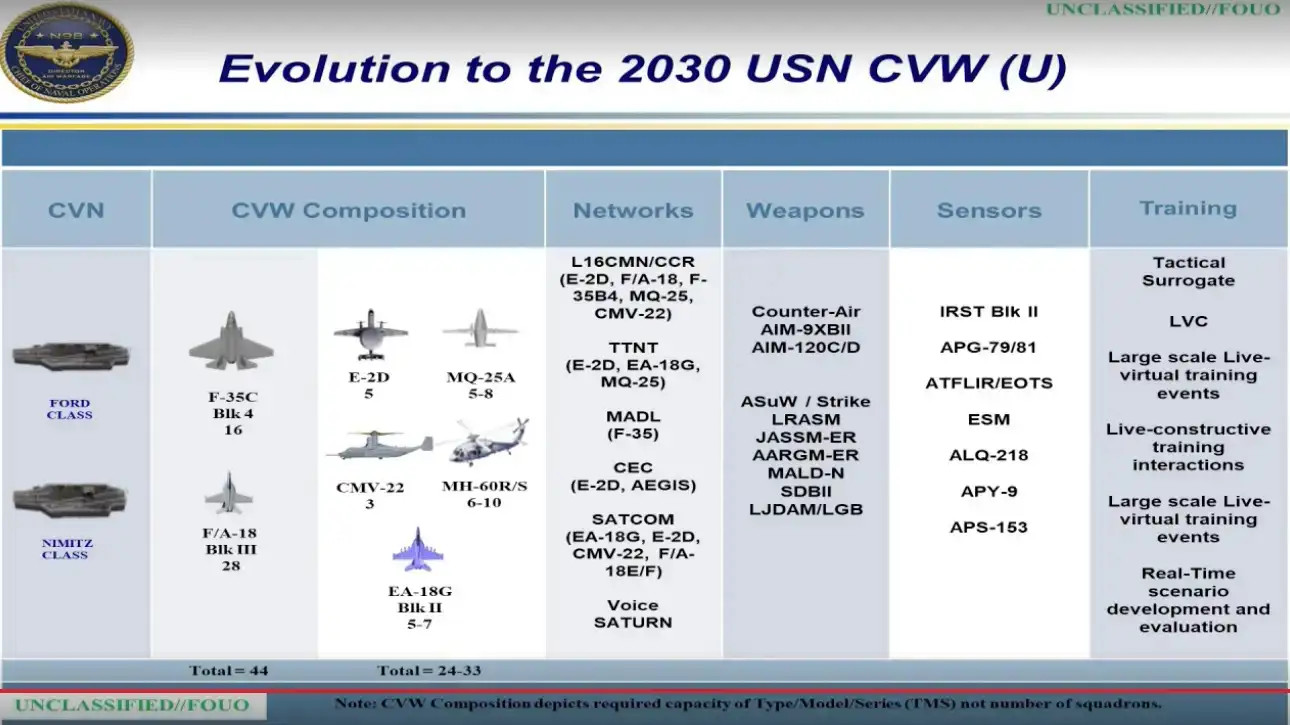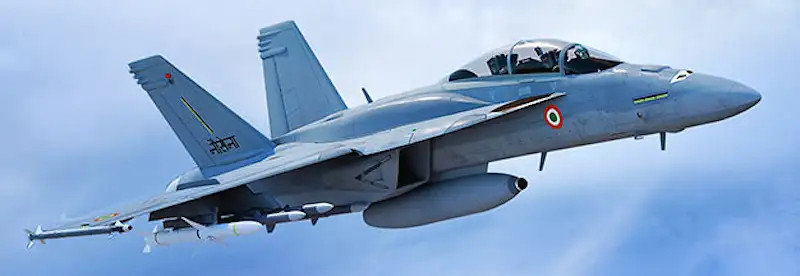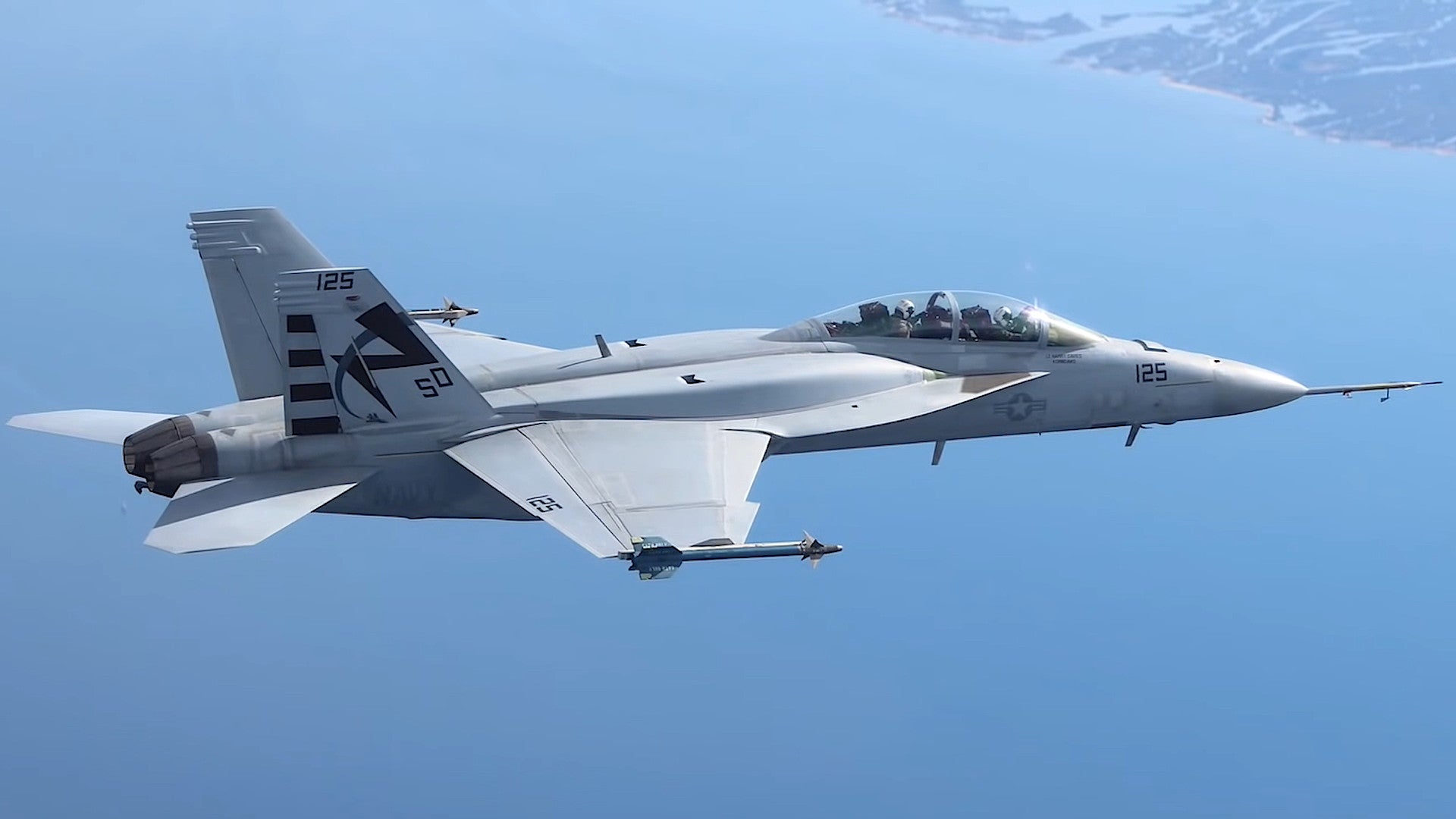The U.S. Navy appears to have all but scrapped its plans to equip its future Block III F/A-18E/F Super Hornets with conformal fuel tanks, or CFTs, at least for the time being. Boeing says it is not presently expecting to deliver any Block III jets with CFTs to the Navy. The service itself has also revealed that it issued a formal stop-work order to Boeing with regards to the continued development of the CFTs back in January.
Tim Martin, Shepard News‘ Air Editor, tweeted out the new details about the CFT’s place, or apparent lack thereof, in the Navy’s Block III Super Hornet upgrade plans earlier today. Aviation Week reported back in January that the Navy was considering axing the tanks, but the service does not look to have disclosed at the time that an actual stop-work was in place. The War Zone has reached out to Naval Air Systems Command (NAVAIR) for more information.

“The U.S. Navy issued stop-work orders to The Boeing Company for work related to Conformal Fuel Tanks (CFTs) on Jan. 6, 2021, to pause the development of the CFT Engineering Change Proposal, citing struggles with cost, schedule, and performance,” the service said, according to Martin.
“The Block III’s coming off our assembly today have the provisions in place to accept a conformal fuel tank in the future,” Boeing also told Shepard News’ Air Editor, while also confirming that the jets would not be fitted with CFTs as standard, as had been expected.
It remains unclear exactly what the issue or issues that the Navy has experienced with the CFTs might be, though the service told Aviation Week previously that “technical, structural, and sustainment” problems had emerged during testing in a “carrier environment.” Boeing’s additional statement to Shepard News’ Martin that it is still offering CFTs as part of its Super Hornet pitches to Canada and Finland, neither of which plan to fly any jets from the deck of a flattop, would seem to reinforce the understanding that whatever is going on is specifically linked to carriers operations in some way.
It is possible that the issue could have to do with a CFT-equipped aircraft’s ability to handle the heavy stresses of landing or taking off from aircraft carriers, including how the tank structures themselves cope with such stresses. It also isn’t clear if the CFTs impede routine maintenance or other tasks, potentially even requiring their removal and reinstallation on a regular basis, which could be a costly and time-consuming proposition and may be even more troublesome aboard the tight confines of an aircraft carrier. Of course, we have to stress that these are just some possibilities.

Additionally, it is worth noting that the most recent annual report regarding the Super Hornet from the Pentagon’s Office of Director of Operational Test and Evaluation, or DOT&E, which covers developments in the program during the 2020 Fiscal Year, makes no mention of CFTs in any way.
Whatever the exact problems are, the Navy’s decision to entirely halt work on the CFTs, which Boeing originally unveiled as part of its Advanced Super Hornet concept in 2008, is significant. The service, as well as Boeing, had long touted the tanks as a critical component of the complete Block III upgrade package, which also includes improvements to help reduce the jet’s radar signature, modernized mission computers and data links, and new wide-area multi-function displays the cockpits, including the rear ones on two-seat F/A-18Fs, that are customizable to best meet mission requirements and user preferences. You can read more about the Block III upgrade effort here.
The Navy has around 540 F/A-18E/F Super Hornets and is planning to bring the vast majority of them up to the Block III standard. In addition, the Navy is putting these jets through other upgrade programs. These include the addition of improved satellite communications (SATCOM) capabilities and the ability to employ an infrared search and track (IRST) system in a modified drop tank. You can read more about the Navy’s IRST work and its significance in this past War Zone feature. There is also Service Life Modification (SLM) process that will extend each aircraft’s expected lifespan out to around 10,000 flight hours, a 50 percent increase over existing Block II Super Hornets.

The CFTs, which are designed to be installed one on either side of the F/A-18E/F’s central spine on top of the jets’ center “barrel” section, had promised to get the upgraded aircraft greater range and performance. The two tanks can hold 515 gallons of fuel, in total, compared to 480 in the standard, draggy drop tank that Navy Super Hornets regualry carry on their centerline stations now. More importantly, the conformal tanks don’t take up space on underwing pylons, freeing them up for additional weapons or other stores.
Boeing had said in the past that a CFT-equipped F/A-18E/F armed with a pair of AIM-9X Sidewinders, two AIM-120 Advanced Medium-Range Air-to-Air Missiles (AMRAAM), and two 2,000-pound-class precision-guided bombs would have a combat radius of 714 nautical miles. A combat radius of a Super Hornet with the same loadout, but only a single centerline drop tank instead of CFTs, would only be 594 nautical miles.
In addition, the new IRST-equipped drop tanks sacrifice fuel to integrate that new capability. CFTs offered a way to mitigate that loss in range on aircraft carrying that sensor system.

CFTs had also been seen as a potentially significant addition to the Navy’s EA-18G Growler electronic warfare planes for the same general reasons.
The Navy, together with Boeing, is still making progress in the development of the MQ-25A Stingray, an unmanned aerial tanker drone. In June, NAVAIR and Boeing announced the first successful aerial refueling of a Super Hornet by the T1 developmental test asset, which is being used to support work on the Stingray program. Earlier this month, T1 also transferred fuel to a Navy E-2D Advanced Hawkeye airborne early warning and control aircraft equipped with an aerial refueling probe for the first time. The service only took delivery of its first non-developmental air-to-air refueling-capable E-2D in 2019.


The Navy expects to reach initial operational capability with the MQ-25A in 2025. Even if it keeps to this schedule, if the service’s F/A-18E/Fs don’t receive CFTs, they will still have less range and stores-carrying capacity in combination with these drones than they would with the tanks. There will also be some amount of demand for these drones to refuel F-35C Joint Strike Fighters, which do not have the ability to carry range-extending drop-tanks at all, at present. Even if an advanced drop tank with stealthy qualities were to be developed for the Joint Strike Fighter, it would have at least some impact on the jet radar-evading characteristics and would be less likely to be employed when these jets need to be at their stealthiest. At the same time, F-35Cs do boast greater range, to being with, than Super Hornets.

All told, the loss of hundreds of miles of potential range for the Navy’s Super Hornets could be a significant issue, especially in any future high-end conflict requiring operations across a broad area, such as a potential one against the Chinese in the Pacific region. The range capabilities of the Navy Super Hornets not only impact the targets that the jets can reach from a carrier’s deck, but also how far that flattop can stay away from enemy defenses. With anti-access and area denial threats, including ever longer-ranged and faster-flying anti-ship cruise and ballistic missiles, only continuing to grow, this is not a minor issue.
All of this does come as the Navy is looking to stop buying any more Super Hornets and shift its attention to a new advanced fighter jet design as part of its Next Generation Air Dominance (NGAD) program. Congress has responded to those plans with skepticism and you can read more about that emerging debate between the Navy and the legislators that control its budget here.
In addition, though Boeing has stressed that CFTs remain part of the packages the company has submitted for fighter competitions in Canada and Finland, the Navy’s decision could still have an impact on export opportunities. While Canada and Finland might plan to operate their jets exclusively from bases on land, this is not the case for all potential Super Hornet customers. Boeing is notably pitching the F/A-18E/F to India as a carrier-based fighter jet and artwork the company has produced of a notional Indian Super Hornet show it fitted with CFTs. Shepard News’ Martin made no mention in his Tweets about whether Boeing is still offering CFTs as part of its Indian bid.

As already noted, Boeing has stressed that the Navy’s Block III Super Hornets will still have the provisions necessary for the installation of CFTs in the future, if the service decides to change course. Right now, whatever issues cropped up in testing appear to have been so severe that the Navy determined that the tanks are more trouble than their worth.
Update 8/26/2021:
Naval Air Systems Command (NAVAIR) has now confirmed directly to The War Zone that it did issue a stop-work order with regards to the conformal fuel tanks (CFT) in the Block III upgrade package on Jan. 6.
“The F/A-18 & EA-18G Program Office (PMA-265), like all U.S. Navy programs, frequently engages with industry to evaluate available technologies and how they could potentially be applied to our platforms and systems; however, this does not mean they are nor will become programs of record,” NAVAIR also said in response to a question about what other range-extension capabilities, or any other strategies to mitigate the decision to halt work on the CFTs, that it might now be exploring now.
Contact the author: joe@thedrive.com
